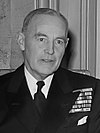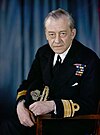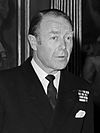
The Home Fleet was a fleet of the Royal Navy that operated from the United Kingdom's territorial waters from 1902 with intervals until 1967. In 1967, it was merged with the Mediterranean Fleet creating the new Western Fleet.

The British Mediterranean Fleet, also known as the Mediterranean Station, was a formation of the Royal Navy. The Fleet was one of the most prestigious commands in the navy for the majority of its history, defending the vital sea link between the United Kingdom and the majority of the British Empire in the Eastern Hemisphere. The first Commander-in-Chief for the Mediterranean Fleet was the appointment of General at Sea Robert Blake in September 1654. The Fleet was in existence until 1967.

The Fifth Sea Lord was formerly one of the Naval Lords and members of the Board of Admiralty that controlled the Royal Navy. The post's incumbent had responsibility for naval aviation.

The Battle Cruiser Fleet, (BCF), later known as Battle Cruiser Force, a naval formation of fast battlecruisers of the Royal Navy, operated from 1915 to 1919.

The Assistant Chief of the Naval Staff (A.C.N.S.) is a senior appointment in the Royal Navy usually a two-star rank and has a NATO ranking code of OF-7.

The Deputy Chief of the Naval Staff (DCNS) is a senior appointment in the Royal Navy currently held by the Second Sea Lord. The incumbent is usually a three-star rank and had a NATO ranking code of OF-8, but the position has previously been held by an acting two-star ranked officer and a four-star ranked officer.

The Deputy First Sea Lord (D.F.S.L.) was a senior Royal Navy flag officer on the Board of Admiralty of the Royal Navy.

The Admiralty War Staff was the former senior naval staff operational planning organisation within the British Admiralty that existed from 1912 to 1917. It was instituted on 8 January 1912 by Winston Churchill in his capacity as First Lord of the Admiralty and was in effect a war council whose head reported directly to the First Sea Lord. After the First World War ended, the War Staff was replaced by the Admiralty Naval Staff department.

The Admiral of Patrols was a former command appointment within the Admiralty during World War I usually held by a junior flag officer the post was established from 1912 to 1916.

The Anti-Submarine Division its original name, was the former anti-submarine warfare, planning and prevention directorate of the Admiralty Department from 1912 to 1963.

The Naval Mobilisation Department also known as the Mobilisation and Movements Department was a former department of the British Admiralty initially from 1909 to 1912 and then again from 1918 to 1932. It was mainly responsible for plans, mobilisation and manning during the pre-World War I and post war period.

The Mobilisation Division was the former Directorate of the British Admiralty Naval Staff responsible for mobilisation requirements, manning and war preparation planning from 1912–1918.

The Gunnery and Torpedo Division was the former Directorate of the Admiralty Naval Staff responsible for weapons policy making, development and assessing weapon requirements from 1918-1920.

The Gunnery Division was a Directorate of the Admiralty Naval Staff of the Royal Navy responsible for the tactical use of naval weapons and the training of naval personnel in relation to operational requirements. It was established in 1920 when the Gunnery and Torpedo Division was separated into an independent Gunnery Division and Torpedo Division. It existed until 1964 when the Department of Admiralty was abolished and replaced by a new Ministry of Defence.

The Training and Staff Duties Division, later known as the Tactical and Staff Duties Division, was a directorate of the Admiralty Naval Staff of the Royal Navy responsible for the tactical use of naval weapons and the training of naval personnel in relation to operational requirements from 1917 to 1958.

The Admiral Commanding, Reserves, was a senior Royal Navy post that existed from 1875 to 1976.

The Commander-in-Chief, Levant was a senior administrative shore commander of the Royal Navy. The post was established in February 1943 when the British Chiefs of Staff Committee ordered the Mediterranean Fleet to be divided into two commands. One was responsible for naval operations involving ships, and the other, administrative and support, was responsible for shore establishments. His subordinate establishments and staff were sometimes informally known as the Levant Command or Levant Station. In December 1943 the title was changed to Flag Officer, Levant and East Mediterranean. In January 1944 the two separate commands were re-unified into a single command merging back into Commander-in-Chief Mediterranean Fleet.

The Directorate of Navigation and Tactical Control (Naval) was a directorate of the Navy Department, Naval Staff first established in 1912, as the Navigation Department of Hydrographic Department of the Admiralty. In 1945, it was renamed the Navigation Division and assigned to the Admiralty Naval Staff. In 1946, it was redesignated Navigation and Direction Division until 1966, and now part of the Navy Department Naval Staff it was renamed the Directorate of Navigation and Tactical Control (Naval). The staff directorate was administered by the Director Navigation Tactical Control (Naval) who reported to the Assistant Chief of the Naval Staff (Warfare) it existed until 1968.

The Directorate Naval Tactical and Weapons Policy originally called the Tactical Section was a directorate of the British Admiralty, and later of the Naval Staff, Ministry of Defence,. Dating from 1920 it operated until 1939 before being abolished. It was revived in 1958 and existed until 1968. The naval staff directorate was administered by the Director, Directorate Naval Tactical and Weapons Policy.

The Torpedo Division originally called the Gunnery and Torpedo Division was a naval staff organisation of the British Admiralty Naval Staff established in 1920 when the functions of the Gunnery and Torpedo Division was divided up into separate functions. It existed until 1928 when it was absorbed into the Tactical Division.














